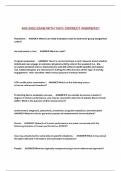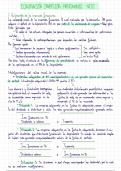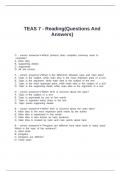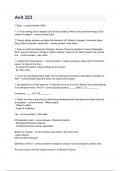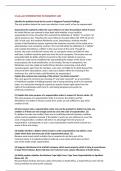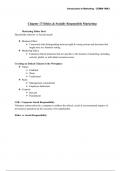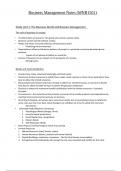5
Student: ___________________________________________________________________________
1. Protists include
A. yeasts and molds.
B. algae and protozoa.
C. helminths.
D. All of the choices are correct.
E. None of the choices are correct.
2. The eucaryotic cell organelle that most resembles a bacterial cell is the
A. nucleus.
B. golgi apparatus.
C. mitochondria.
D. lysosome.
E. ribosome.
3. Eucaryotic flagella differ from procaryotic flagella because only eucaryotic flagella
A. are used for cell motility.
B. facilitate chemotaxis.
C. facilitate phototaxis.
D. are long whip-like structures.
E. contain microtubules.
4. Cilia are found in certain
A. protozoa.
B. algae.
C. fungi.
D. bacteria.
E. All of the choices are correct.
,5. Chitin is a chemical component of the cell walls of
A. protozoa.
B. algae.
C. fungi.
D. bacteria.
E. All of the choices are correct.
6. Cell walls are not found on typical cells of
A. protozoa.
B. algae.
C. fungi.
D. bacteria.
E. All of the choices are correct.
7. The site for ribosomal RNA synthesis is the
A. ribosome.
B. nucleolus.
C. nucleus.
D. golgi apparatus.
E. lysosome.
8. When a eucaryotic cell is not undergoing mitosis, the DNA and its associated proteins
appear as a visible thread-like mass called the
A. nuclear envelope.
B. nucleosome.
C. nucleolus.
D. nucleoplasm.
E. chromatin.
9. Histones are
A. found in polyribosomes.
B. enzymes found in lysosomes.
C. proteins of the cytoskeleton.
D. proteins associated with DNA in the nucleus.
E. on the surface of rough endoplasmic reticulum.
, 10. The eucaryotic cell's glycocalyx is
A. mostly polysaccharide.
B. the site where many metabolic reactions occur.
C. also called the cell wall.
D. composed of many diverse proteins.
E. protection against osmotic lysis.
11. Which of the following is found in eucaryotic cells but not in procaryotic cells?
A. nucleus
B. mitochondria
C. endoplasmic reticulum
D. lysosomes
E. All of the choices are correct.
12. The endosymbiotic theory says that precursor eucaryotic cells acquired flagella by
endosymbiosis with a _____ ancestor, and others gained photosynthetic ability from
endosymbiosis with a _____ ancestor.
A. protozoan, algae
B. archaea, cyanobacteria
C. spirochete, cyanobacteria
D. helminth, algae
E. None of the choices are correct.
13. The cell's series of tunnel-like membranes functioning in transport and storage are
the
A. mitochondria.
B. lysosomes.
C. golgi apparatus.
D. chloroplasts.
E. endoplasmic reticulum.
14. An organelle that is a stack of flattened, membranous sacs and functions to receive,
modify, and package proteins for cell secretion is the
A. mitochondria.
B. lysosomes.
C. golgi apparatus.
D. chloroplasts.
E. endoplasmic reticulum.
Student: ___________________________________________________________________________
1. Protists include
A. yeasts and molds.
B. algae and protozoa.
C. helminths.
D. All of the choices are correct.
E. None of the choices are correct.
2. The eucaryotic cell organelle that most resembles a bacterial cell is the
A. nucleus.
B. golgi apparatus.
C. mitochondria.
D. lysosome.
E. ribosome.
3. Eucaryotic flagella differ from procaryotic flagella because only eucaryotic flagella
A. are used for cell motility.
B. facilitate chemotaxis.
C. facilitate phototaxis.
D. are long whip-like structures.
E. contain microtubules.
4. Cilia are found in certain
A. protozoa.
B. algae.
C. fungi.
D. bacteria.
E. All of the choices are correct.
,5. Chitin is a chemical component of the cell walls of
A. protozoa.
B. algae.
C. fungi.
D. bacteria.
E. All of the choices are correct.
6. Cell walls are not found on typical cells of
A. protozoa.
B. algae.
C. fungi.
D. bacteria.
E. All of the choices are correct.
7. The site for ribosomal RNA synthesis is the
A. ribosome.
B. nucleolus.
C. nucleus.
D. golgi apparatus.
E. lysosome.
8. When a eucaryotic cell is not undergoing mitosis, the DNA and its associated proteins
appear as a visible thread-like mass called the
A. nuclear envelope.
B. nucleosome.
C. nucleolus.
D. nucleoplasm.
E. chromatin.
9. Histones are
A. found in polyribosomes.
B. enzymes found in lysosomes.
C. proteins of the cytoskeleton.
D. proteins associated with DNA in the nucleus.
E. on the surface of rough endoplasmic reticulum.
, 10. The eucaryotic cell's glycocalyx is
A. mostly polysaccharide.
B. the site where many metabolic reactions occur.
C. also called the cell wall.
D. composed of many diverse proteins.
E. protection against osmotic lysis.
11. Which of the following is found in eucaryotic cells but not in procaryotic cells?
A. nucleus
B. mitochondria
C. endoplasmic reticulum
D. lysosomes
E. All of the choices are correct.
12. The endosymbiotic theory says that precursor eucaryotic cells acquired flagella by
endosymbiosis with a _____ ancestor, and others gained photosynthetic ability from
endosymbiosis with a _____ ancestor.
A. protozoan, algae
B. archaea, cyanobacteria
C. spirochete, cyanobacteria
D. helminth, algae
E. None of the choices are correct.
13. The cell's series of tunnel-like membranes functioning in transport and storage are
the
A. mitochondria.
B. lysosomes.
C. golgi apparatus.
D. chloroplasts.
E. endoplasmic reticulum.
14. An organelle that is a stack of flattened, membranous sacs and functions to receive,
modify, and package proteins for cell secretion is the
A. mitochondria.
B. lysosomes.
C. golgi apparatus.
D. chloroplasts.
E. endoplasmic reticulum.

